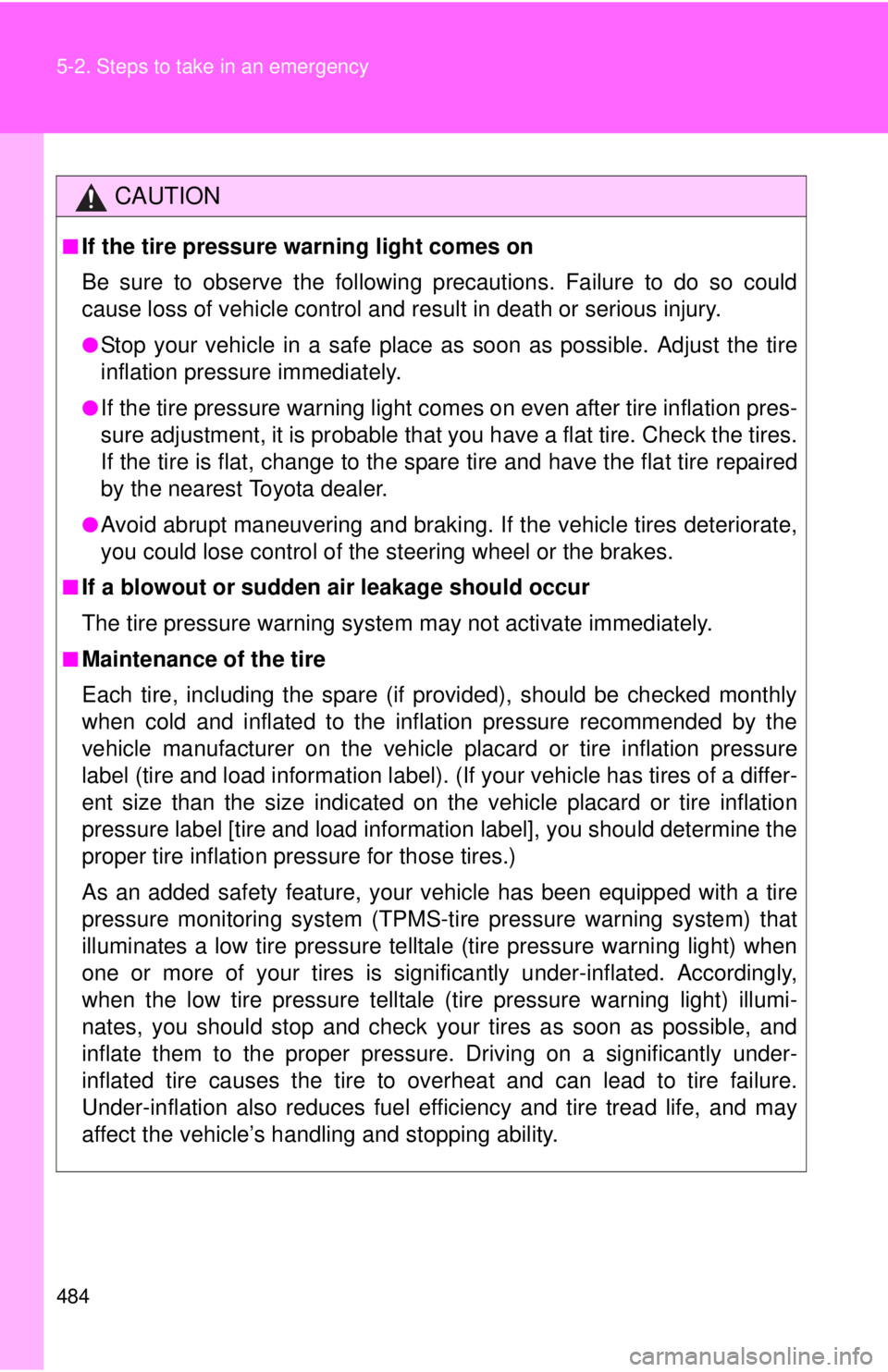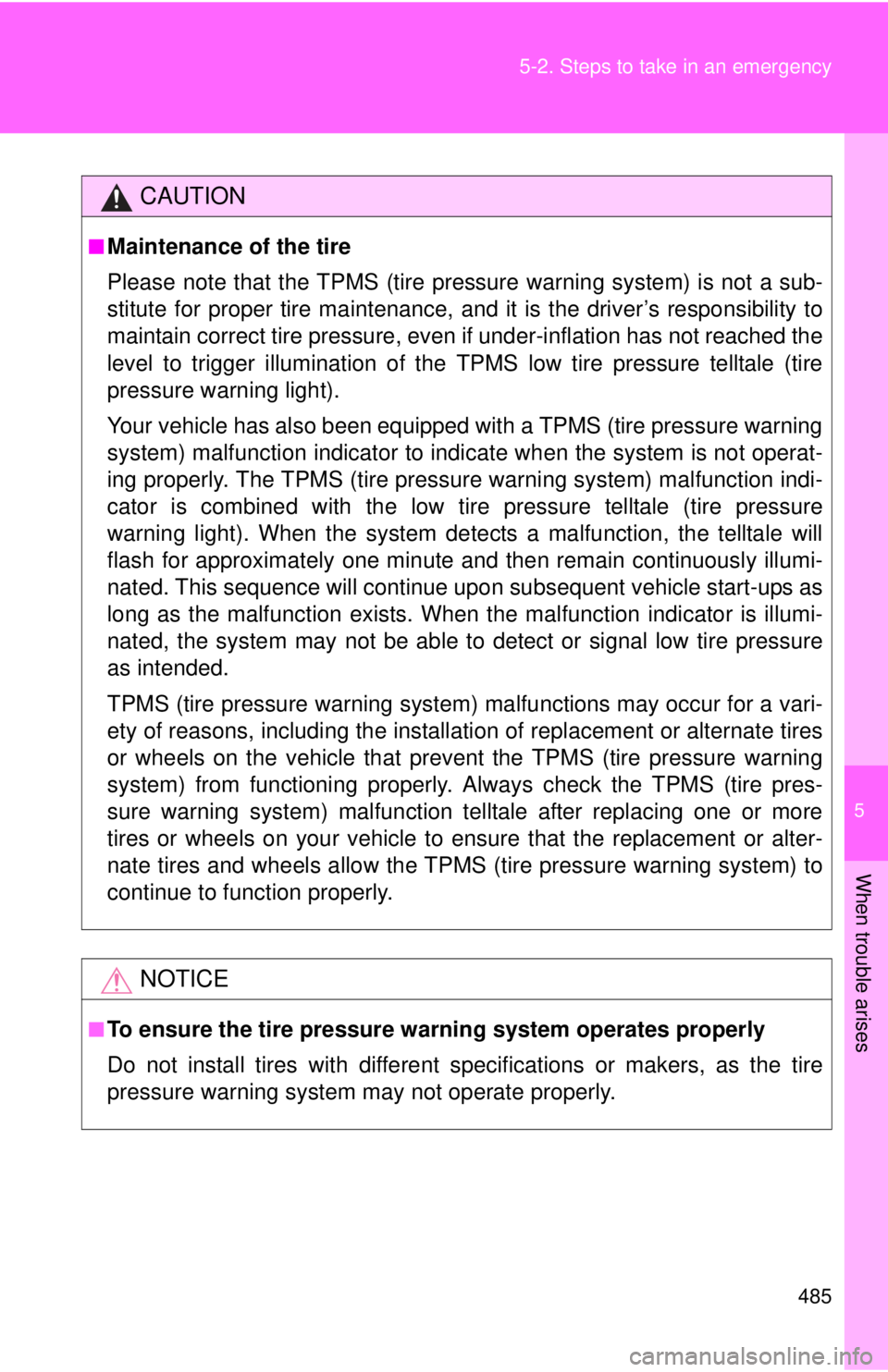Page 461 of 590
461
4-3. Do-it-yourself maintenance
4
Maintenance and care
■
High mounted stoplight
Remove the screws and cover.
Remove the light bulbs.
Page 462 of 590
462 4-3. Do-it-yourself maintenance
■License plate lights
Remove the screw and light unit.
Turn the bulb base counterclock-
wise.
Remove the light bulb.
Page 463 of 590
463
4-3. Do-it-yourself maintenance
4
Maintenance and care
■
Lights other than the above
If any of the lights listed below has burnt out, have it replaced by
your Toyota dealer.
• Side turn signal lights (if equipped)
• Stop/tail lights (LED type)
• Rear side marker lights (LED type)
■ Condensation build-up on th e inside of the lens
Temporary condensation build-up on the inside of the headlight lens does
not indicate a malfunction. Contact your Toyota dealer for more information
in the following situations:
● Large drops of water are built up on the inside of the lens.
● Water has built up inside the headlight.
■ LED light bulbs
The side turn signal lights (if equipped), stop/tail and rear side marker lights
(LED type) consist of a number of LEDs. If any of the LEDs burn out, take
your vehicle to your Toyota dealer to have the light replaced.
If two or more LEDs in a stop light burn out, your vehicle may not conform to
local laws (SAE).
Page 464 of 590
464 4-3. Do-it-yourself maintenance
CAUTION
■Replacing light bulbs
●Turn off the headlights. Do not attempt to replace the bulb immediately
after turning off the headlights.
The bulbs become very hot and may cause burns.
● Do not touch the glass portion of the light bulb with bare hands. When i\
t is
unavoidable to hold the glass portion, use and hold with a clean dry cloth
to avoid getting moisture and oils on the bulb.
Also, if the bulb is scratched or dropped, it may blow out or crack.
● Fully install light bulbs and any parts used to secure them. Failing to do so
may result in heat damage, fire, or water entering the headlight unit. This
may damage the headlights or cause condensation to build up on the lens.
■ To prevent damage or fire
Make sure bulbs are fully seated and locked.
Page 481 of 590

5
When trouble arises
481
5-2. Steps to take in an emergency
*1: Driver’s and front passenger’s seat belt buzzer:
The driver’s and front passenger’s seat belt buzzer sounds to alert the driver
and front passenger that their seat belt is not fastened. Once the engine
switch is turned to the ON or START position, the buzzer sounds for 6 sec-
onds. The buzzer sounds once if the driver’s or front passenger’s seat belt
is unfastened when the vehicle reaches a speed of 12 mph (20 km/h). Then,
if the seat belt is still unfastened after 30 seconds elapse, the buzzer will
sound intermittently for approximately 10 seconds, followed by a different
tone for approximately 20 more seconds.
*2: Refer to the separate “Scheduled Maintenance Guide” or “Owner’s ManualSupplement” for the maintenance interval applicable to your vehicle. (U.S.A.)
Maintenance required
reminder light
Indicates that mainte-
nance is required accord-
ing to the driven distance
on the maintenance
schedule.
*2
Illuminates for about 3
seconds and then
flashes for about 15 sec-
onds approximately 4500
miles (7200 km) after the
reminder light has been
reset. If necessary, perform
maintenance.
Comes on and remains
on if the distance driven
exceeds 5000 miles
(8000 km) after the
reminder light has been
reset.
(The indicator will not
work properly unless the
reminder light has been
reset.) Perform the necessary
maintenance.
Please reset the
reminder light after the
maintenance is per-
formed. (P. 395)
Warning lightWarning light/DetailsCorrection procedure
Page 484 of 590

484 5-2. Steps to take in an emergency
CAUTION
■If the tire pressure warning light comes on
Be sure to observe the following precautions. Failure to do so could
cause loss of vehicle control and re sult in death or serious injury.
●Stop your vehicle in a safe place as soon as possible. Adjust the tire
inflation pressure immediately.
●If the tire pressure warning light comes on even after tire inflation pres-
sure adjustment, it is pr obable that you have a flat tire. Check the tires.
If the tire is flat, change to the spare tire and have the flat tire repaired
by the nearest Toyota dealer.
●Avoid abrupt maneuvering and braking. If the vehicle tires deteriorate,
you could lose control of the steering wheel or the brakes.
■If a blowout or sudden air leakage should occur
The tire pressure warning syste m may not activate immediately.
■Maintenance of the tire
Each tire, including the spare (if provided), should be checked monthly
when cold and inflated to the inflation pressure recommended by the
vehicle manufacturer on the vehicle placard or tire inflation pressure
label (tire and load information label). (If your vehicle has tires of a differ-
ent size than the size indicated on the vehicle placard or tire inflation
pressure label [tire and load information label], you should determine the
proper tire inflation pr essure for those tires.)
As an added safety feature, your vehicle has been equipped with a tire
pressure monitoring system (TPMS-ti re pressure warning system) that
illuminates a low tire pressure telltal e (tire pressure warning light) when
one or more of your tires is significantly under-inflated. Accordingly,
when the low tire pressu re telltale (tire pressure warning light) illumi-
nates, you should stop and check your tires as soon as possible, and
inflate them to the proper pressure. Driving on a significantly under-
inflated tire causes the tire to overheat and can lead to tire failure.
Under-inflation also reduces fuel effi ciency and tire tread life, and may
affect the vehicle’s handling and stopping ability.
Page 485 of 590

5
When trouble arises
485
5-2. Steps to take in an emergency
CAUTION
■Maintenance of the tire
Please note that the TPMS (tire pressure warning system) is not a sub-
stitute for proper tire ma
intenance, and it is the driver’s responsibility to
maintain correct tire pressure, even if under-inflation has not reached the
level to trigger illu mination of the TPMS low ti re pressure telltale (tire
pressure warning light).
Your vehicle has also been equipped with a TPMS (tire pressure warning
system) malfunction indicator to indi cate when the system is not operat-
ing properly. The TPMS (tire pressure warning system) malfunction indi-
cator is combined with the low tire pressure telltale (tire pressure
warning light). When the system det ects a malfunction, the telltale will
flash for approximately one minute an d then remain continuously illumi-
nated. This sequence will continue upon subsequent vehicle start-ups as
long as the malfunction exists. When the malfunction indi cator is illumi-
nated, the system may not be able to detect or signal low tire pressure
as intended.
TPMS (tire pressure warning system) malfunctions may occur for a vari-
ety of reasons, including the installati on of replacement or alternate tires
or wheels on the vehicle that prevent the TPMS (tire pressure warning
system) from functioning properly. Always check the TPMS (tire pres-
sure warning system) malfunction te lltale after replacing one or more
tires or wheels on your vehicle to ensure that the replacement or alter-
nate tires and wheels allow the TPMS (tire pressure warning system) to
continue to function properly.
NOTICE
■To ensure the tire pressure warning system operates properly
Do not install tires with different s pecifications or makers, as the tire
pressure warning system may not operate properly.
Page 517 of 590
Vehicle specifications6
515
6-1. SpecificationsMaintenance data (fuel, oil level, etc.) ......... 516
Fuel information ............... 537
Tire information ................ 540
6-2. Customization Customizable features ..... 551
Items to initialize .............. 552